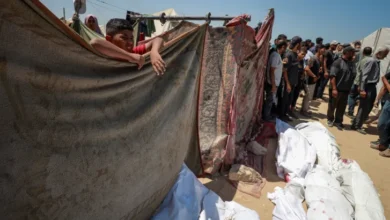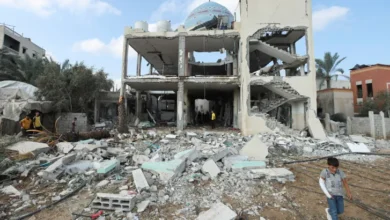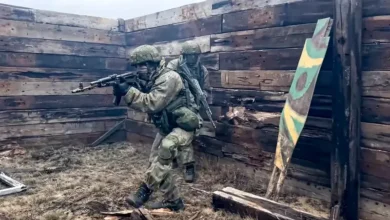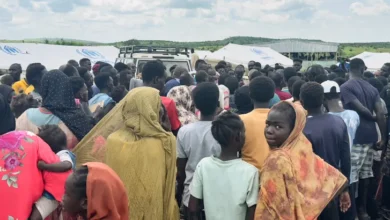Swallowed by the sea, Pakistan’s Indus delta now threatened by canals
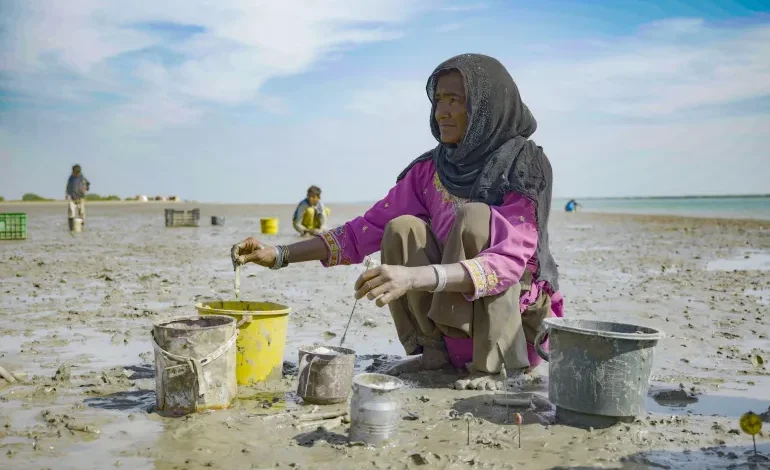
On a sunny afternoon at Dando Jetty, a small fishing village in Pakistan’s sprawling Indus Delta, a boat is being unloaded and another is about to leave for the Arabian Sea.
The melodious voice of Sindhi folk singer Fouzia Soomro rises from a loudspeaker playing on a nearby parked boat.About 130km (81 miles) from Pakistan’s largest city of Karachi, Dando Jetty sits on the bank of Khobar Creek, one of the two surviving creeks of the Indus River in Thatta, a coastal district in the eastern Sindh province.
“There should be freshwater in this creek, flowing into the sea,” Zahid Sakani tells Al Jazeera as he embarks on a boat to visit his ancestral village, Haji Qadir Bux Sakani, in Kharo Chan, a sub-district of Thatta, three hours away. “Instead, it’s seawater.”
Six years ago, Sakani, 45, used to be a farmer. But his land, along with the rest of Haji Qadir Bux Sakani village, was swallowed by the sea, forcing him to migrate to Baghan, 15km (nine miles) from Dando Jetty, and turn to tailoring for survival.dogs roam freely, and abandoned boats outnumber those that are still in service. Sakani sometimes goes to Kharo Chan to visit the graves of his father and other ancestors.
“We cultivated 200 acres [81 hectares] of land and raised livestock here,” said Sakani as he stood at the port. “But all were lost to the sea.”
Kharo Chan was once a prosperous area comprising of 42 “dehs” (villages), of which only three now exist. The rest were submerged into the sea, forcing thousands of people to migrate to other villages or Karachi city.
According to the government census, Kharo Chan’s population shrunk from 26,000 in 1988 to 11,403 in 2023.
It was not only Kharo Chan that met this fate. In the past decade, dozens of villages in the Indus Delta have disappeared, swallowed by the advancing sea.New canal projects
And now, a new threat has emerged in an already fragile ecosystem.
As part of a so-called Green Pakistan Initiative, the Pakistan government is seeking $6bn investment from Saudi Arabia, the United Arab Emirates, Qatar and Bahrain over the next three to five years for corporate farming, aiming to cultivate 1.5 million acres (600,000 hectares) of barren land, and mechanise the existing 50 million acres (20 million hectares) of agricultural land across the country.
The project aims to irrigate a total of 4.8 million acres (1.9 million hectares) of barren land by constructing six canals – two each in Sindh, Balochistan, and Punjab provinces. Five of those canals will be on the Indus, while the sixth will be constructed along the Sutlej River to irrigate the Cholistan Desert in Pakistan’s most populous Punjab province.According to the 1960 Indus Water Treaty, a World Bank-brokered water distribution agreement between India and Pakistan, the waters of the Sutlej primarily belong to India. It is one of the five rivers that originate in India and fall into the Indus in Pakistan. Along with the Sutlej, the waters of the Ravi and Beas Rivers also belong to India under the treaty, while the waters of the Chenab and Jhelum, apart from Indus itself are Pakistan’s.
However, the Sutlej does bring water to Pakistan during the monsoons in India, with Cholistan historically reliant on rainfall for irrigation.
“They will divert water from Indus to Sutlej through Chenab and then to Cholistan canal,” said Obhayo Khushuk, a former irrigation engineer. “You cannot build a new irrigation system depending on [monsoon] floodwater.”
Meanwhile, corporate farming has already begun in Cholistan under the Green Pakistan Initiative, with the authorities approving 4,121 cusecs of water to irrigate 0.6 million acres (24,000 hectares) of land in the Cholistan Desert – an area larger than Lahore, Pakistan’s second-largest city.
Mohammad Ehsan Leghari, Sindh’s representative in the Indus River System Authority (IRSA), a regulatory body established in 1992 to oversee the allocation of water to Pakistan’s four provinces, strongly opposed the move.
“From 1999 to 2024, not a single year has passed without water shortage in Pakistan, with Sindh and Balochistan provinces facing up to 50 percent water scarcity during the summer. In this situation, where will the water for the proposed canal system come from?” he asked.
